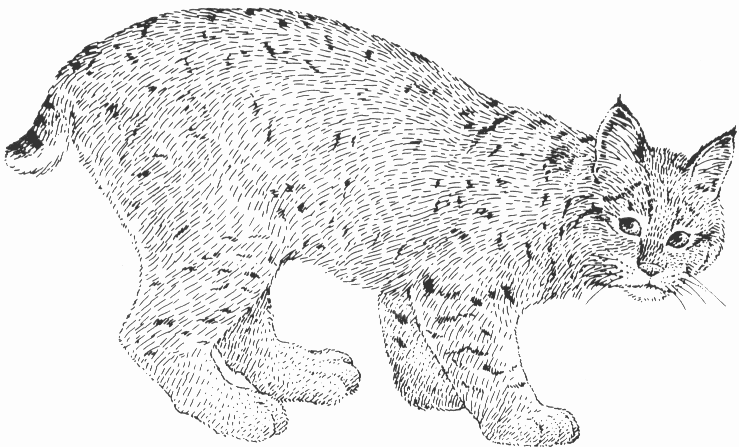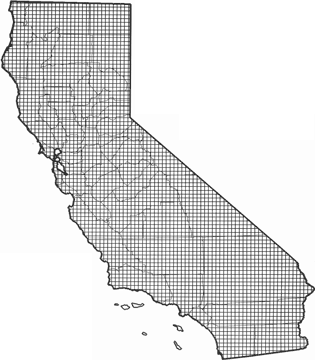
Bobcat
Distribution, Abundance, and Seasonality
Common to uncommon, permanent resident throughout most of California. Use nearly all habitats and successional stages. Optimal habitats are brushy stages of low and mid-elevation conifer, oak, riparian, and pinyon-juniper forests, and all stages of chaparral.

Range Map
Specific Habitat Requirements
Feeding: Bobcats largely are carnivorous. They eat various lagomorphs, rodents, a few deer (mostly young fawns), and some birds, reptiles, amphibians, and invertebrates. They also may consume substantial amounts of vegetation, mostly fruits and some grass (Provost et al. 1973, Fritts and Sealander 1978b). These cats stalk or ambush prey on the ground, from trees, or atop logs or rocks. Usually pursue prey for only a few leaps or bounds. May cache when prey abundant or too large to consume in 1 day.
Cover: Use cavities in rock areas, hollow logs, snags, stumps, and dense brush for cover.
Reproduction: Dens usually located in cavities in rock areas, in hollow logs, snags, stumps, or in dense brush.
Water: No information on water needs found. Probably need to drink water regularly.
Pattern: Suitable habitats for bobcats consist of large areas of broken, rough, rocky terrain supporting brushy deciduous and conifer forests or chaparral, adjacent to smaller areas of riparian habitat and stands of dense forest. Availability of water may limit bobcat distribution in xeric regions.
Species Life History
Activity Patterns: Active yearlong. Mostly nocturnal and crepuscular, some diurnal activity.
Seasonal Movements / Migration: Non-migratory. Distances travelled in 24 hr ranged from 2.6 km (1.6 mi) for an adult female, to 4.8 km (3 mi) for adult males.
Home Range: Female home ranges usually overlap very little; those of males may overlap those of other males or females (Bailey 1974). In Riverside Co., Zezulak and Schwab (1980) reported that home ranges of 7 bobcats varied from 4.7-53.6 km? (1.8-20.7 mi?), with a mean of 26.3 km? (10.3 mi?). In Idaho, home ranges of females averaged 19.3 km? (75 mi?), and varied from 9.1-45.3 km? (3.5-17.5 mi?). Those of males averaged 42.1 km? (16.3 mi?), and varied from 6.5-107.9 km? (2.5-41.7 mi?) (Bailey 1974).
Territory: Scent marking appears to reduce actual contact, and fighting is very unusual. In Idaho, territory and home range probably coincide (Bailey 1974,1981). In northeastern California, Zezulak (1981) reported that home ranges overlapped up to 30% among females, but there was almost no overlap among males. In southern California, Lembeck (1978) noted almost no overlap of female home ranges, and up to 89% overlap among males. Zezulak and Schwab (1980) reported results intermediate to Zezulak (1981) and Lembeck (1978). Zezulak and Schwab (1980) speculated that bobcats may be territorial in some situations, but not all. This flexibility in behavior results in higher population levels where they are not territorial.
Reproduction: Bobcats usually breed in winter (Young 1958, Gashwiler et al. 1961). Gestation period 60-70 days; most young probably born in spring in California. Litter size averaged 3.5 in Wyoming, 2.8 in Utah, and 2.5 in Arkansas; range = 1-7. One litter/yr. Females polyestrous. Females breed in first yr; males in second yr. Lactation continues about 60 days. Individuals may live 10-14 yr.
Niche: Great horned owls may kill young bobcats (Jackson 1961), and adults occasionally are taken by mountain lions (Young 1958) and domestic dogs. Bobcats and coyotes may compete (Robinson 1961), and when coyote numbers are reduced by predator control, bobcat numbers may increase (Nunley 1978).
Sources & References
California Department of Fish and Game, 1999.
California's Wildlife, Sacramento, CA.
Written by: G. Ahlborn, reviewed by: M. White, edited by: M. White, G. Ahlborn
Bailey, T. N. 1974. Social organization in a bobcat population. J. Wildl. Manage. 38:435-446. Bailey, T. N. 1981. Factors of bobcat social organization and some management implications. Pages 984-1000 in J. A. Chapman and D. Pursley, eds. Worldwide Furbearer Conf. Procs. 3 vols. 2056pp. Crowe, D. M. 1975. Aspects of ageing, growth, and reproduction of bobcats from Wyoming. J. Mammal. 56:177-198. Fritts, S. H., and J. A. Sealander. 1978a. Reproductive biology and population characteristics of bobcats (Lynx rufus) in Arkansas. J. Mammal. 59:347-353. Fritts, S. H., and J. A. Sealander. 1978b. Diets of bobcats in Arkansas with special reference to age and sex differences. J. Wildl. Manage. 42:533-539. Gashwiler, J. S., W. L. Robinette, and O. W. Morris. 1961. Breeding habits of bobcats in Utah. J . Mammal. 42:76-84. Jackson, H. H. T. 1961. Mammals of Wisconsin. Univ. Wisconsin Press, Madison. 504pp. Lembeck, M. 1978. Bobcat study, San Diego County, California. Calif. Dep. Fish and Game, Sacramento. Project E-W-2, Study IV, Job 1.7. 22pp. Nunley, G. L. 1978. Present and historical bobcat population trends in New Mexico and the west. Proc. Vertebr. Pest Conf. 8:177-184. Provost, E. E., C. A. Nelson, and D. A. Marshall. 1973. Population dynamics and behavior in the bobcat. Pages 42-67 in R. L. Eaton, ed. The world's cats. vol. 1. Ecology and conservation. World Wildl. Safari, Winston, Or. 349pp. Robinson, W. B. 1961. Population changes in carnivores in some coyote-control areas. J. Mammal. 42:510-515. Young, S. P. 1958. The bobcat of North America. Wildl. Manage. Inst., Wash., DC. 193pp. Zezulak, D. S. 1981. Northeastern California bobcat study. Calif. Dep. Fish and Game, Sacramento. Fed. Aid Wildl. Rest. Proj. W-54-R-12, Job IV-3. 19pp. Zezulak, D. S., and R. G. Schwab. 1980. Bobcat biology in a Mojave Desert community. Calif. Dep. Fish and Game, Sacramento. Fed. Aid Wildl. Rest. Proj. W-54-R-12, Job IV-4. 25pp.
California Animal Facts | California's Wildlife